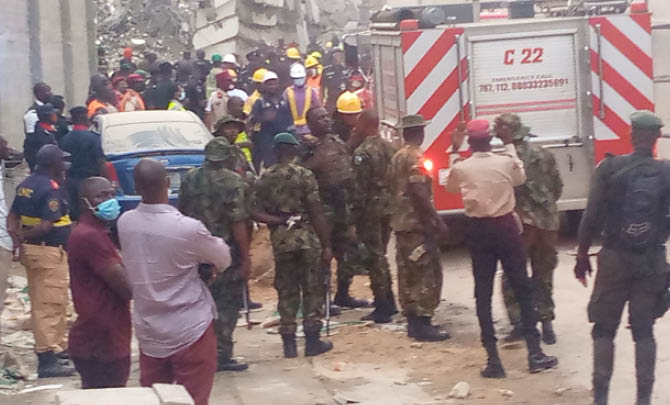Criminal prosecution must follow probe of Ikoyi building collapse
The collapse of a 21-storey skyscraper under construction on Gerard Road, Ikoyi, Lagos, last Monday was a horrifying national tragedy that made Nigerians to regard with suspicion the quality of structural and civil engineering professionals in the country. The monumental disaster claimed the life of Femi Osibona, believed to be the chief executive officer of […]

Scene of the collapsed building on Gerrard Road, in Lagos
The collapse of a 21-storey skyscraper under construction on Gerard Road, Ikoyi, Lagos, last Monday was a horrifying national tragedy that made Nigerians to regard with suspicion the quality of structural and civil engineering professionals in the country. The monumental disaster claimed the life of Femi Osibona, believed to be the chief executive officer of Fourscore Height Limited, owners of the ill-fated building. But beyond the death of Osibona, more than 40 corpses have been recovered from the construction site, while Lagos State Governor Babajide Sanwo-Olu has revealed that 49 family members had reported to government that their family members were missing.
The frequency at which high-rise buildings have collapsed in Lagos State in the last 10 years puts to question the integrity of many structures in the state. For instance, in 2014, as many as 115 persons lost their lives in a high-rise building owned by the Synagogue Church of All Nations (SCOAN) in Lagos. If there has been a thorough investigation into that mass deaths, then not enough lessons have been learnt from the tragedy, as similar calamities have continued to befall Lagos residents several years after. In 2016, some 35 persons lost their lives to high-rise building collapse in Lagos. Also, in 2017, 12 persons died in collapsed buildings; while in 2019, 26 deaths were recorded, mainly from high-rise buildings. But incidents of collapsed buildings are not restricted to Lagos. Data mined by Daily Trust showed that as many as 72 incidents of building collapse have occurred in 2021 alone; that is to say, more than one building collapses every week in the country.
Ikoyi skyscraper collapse is a metaphor for failure in regulation, incompetence among professionals, compromises on quality of building materials used in the building, and absolute disregard for human lives; the tragedy may be an act of manslaughter in which those who looked the other way when standards were being violated are complicit. With modern technology and innovations in the construction sector, it is possible to determine if the soil where a building is being erected can sustain it; or the quantity and quality of materials needed to cast the foundation upon which other floors would be built. In societies that attach importance to human life, every stage of any high-rise structure is dispassionately subjected to critical test to ensure their integrity. If eye-witness accounts are to be believed, the 21-storey building went down from a pillar that broke off. That meant that the quality of materials used in casting that pillar was questionable.
Also, it was widely reported that one of the consultants to Fourscore wrote a letter complaining about the integrity of the project, saying“We can guarantee the integrity of the first two buildings and also works done up to the fourth floor of the third building supervised by us provided specifications have been met in terms of the required concrete strength. This we do not have control over as we do not have the concrete cube test results for each stage of the building till date…”
We call on the Lagos State government to set up a probe panel to thoroughly investigate the circumstances under which the building collapsed. Every contractor that contributed to the project must be brought to question, including architects, soil engineers, suppliers of building materials, civil engineers, building regulatory agency in Lagos, and many other professionals who played a role that caused the disaster. Anyone found wanting for any reason must be prosecuted for criminal negligence. Nigeria is not the only country where high-rise structures have become necessary. Countries like Japan, Malaysia, Hong Kong, United States with high population density and scarcity of land have resorted to be construction of skyscrapers and even mega-tall skyscrapers. The technology to achieve success in the construction of skyscrapers is now commonplace. It is, therefore, unacceptable for Nigeria’s structural and civil engineers to cause deaths through complacency, negligence, and even corruption.
It is also time for all civil engineering professional organizations go into soul-searching exercise about their disservice to the nation and the unnecessary deaths and sorrow their members have brought upon many families. They must retrain their certified members on modern approaches to the construction of skyscrapers, and weed out the bad eggs who violate the ethics of the industry. They must do everything possible to ensure that the Ikoyi 21-storey building collapse is the last of such embarrassing tragedy in Nigeria. It was one disaster too many. Furthermore, all those who were injured in the incident and families of the deceased must be compensated.
